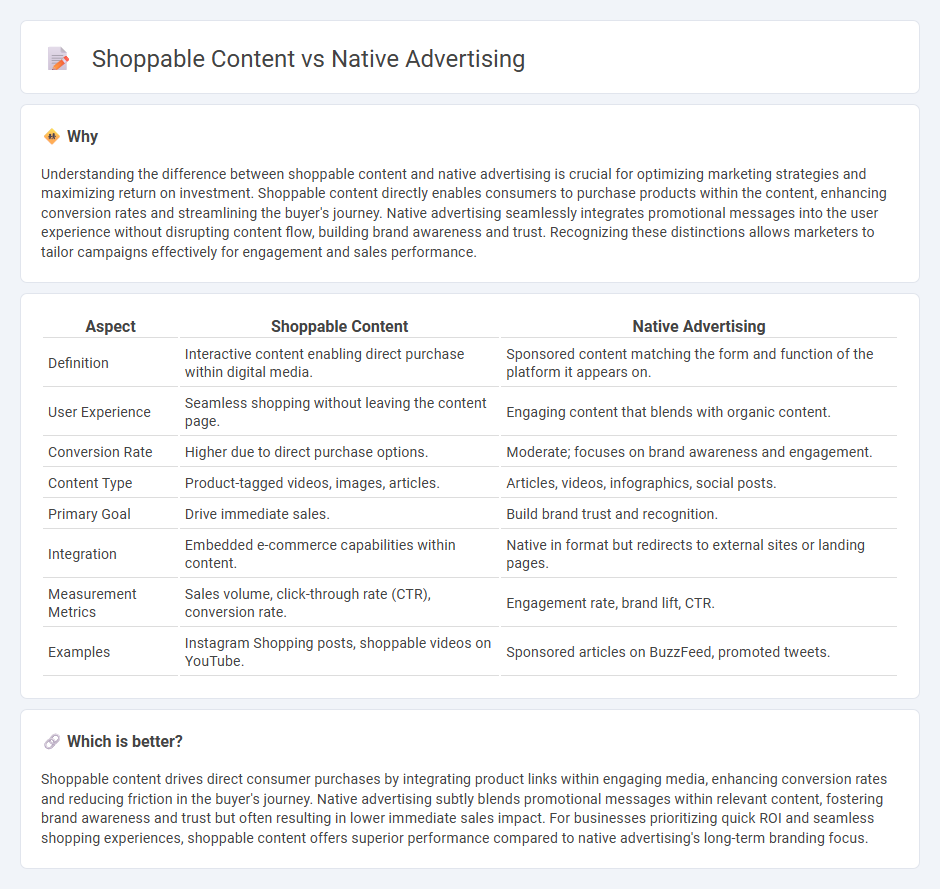
Shoppable content integrates direct purchase options within engaging media, driving immediate sales by blending product discovery with seamless transactions. Native advertising subtly aligns promotional messages with the platform's style and audience interests to build brand trust without disrupting user experience. Explore how these strategies can elevate your marketing effectiveness and customer engagement.
Why it is important
Understanding the difference between shoppable content and native advertising is crucial for optimizing marketing strategies and maximizing return on investment. Shoppable content directly enables consumers to purchase products within the content, enhancing conversion rates and streamlining the buyer's journey. Native advertising seamlessly integrates promotional messages into the user experience without disrupting content flow, building brand awareness and trust. Recognizing these distinctions allows marketers to tailor campaigns effectively for engagement and sales performance.
Comparison Table
| Aspect | Shoppable Content | Native Advertising |
|---|---|---|
| Definition | Interactive content enabling direct purchase within digital media. | Sponsored content matching the form and function of the platform it appears on. |
| User Experience | Seamless shopping without leaving the content page. | Engaging content that blends with organic content. |
| Conversion Rate | Higher due to direct purchase options. | Moderate; focuses on brand awareness and engagement. |
| Content Type | Product-tagged videos, images, articles. | Articles, videos, infographics, social posts. |
| Primary Goal | Drive immediate sales. | Build brand trust and recognition. |
| Integration | Embedded e-commerce capabilities within content. | Native in format but redirects to external sites or landing pages. |
| Measurement Metrics | Sales volume, click-through rate (CTR), conversion rate. | Engagement rate, brand lift, CTR. |
| Examples | Instagram Shopping posts, shoppable videos on YouTube. | Sponsored articles on BuzzFeed, promoted tweets. |
Which is better?
Shoppable content drives direct consumer purchases by integrating product links within engaging media, enhancing conversion rates and reducing friction in the buyer's journey. Native advertising subtly blends promotional messages within relevant content, fostering brand awareness and trust but often resulting in lower immediate sales impact. For businesses prioritizing quick ROI and seamless shopping experiences, shoppable content offers superior performance compared to native advertising's long-term branding focus.
Connection
Shoppable content integrates product links directly within engaging media, enabling seamless purchasing experiences that align with native advertising's unobtrusive promotional style. Both strategies prioritize user experience by blending marketing messages naturally into the content environment, increasing conversion rates and brand interaction. Leveraging data-driven targeting, shoppable content within native ads enhances personalization and engagement, driving higher return on investment (ROI) in digital marketing campaigns.
Key Terms
Integration
Native advertising seamlessly blends branded content with editorial environments, enhancing user engagement by matching the platform's look and feel. Shoppable content integrates e-commerce functionality directly into content, allowing consumers to purchase products without leaving the experience. Explore how these strategies enhance marketing ROI and drive conversions by learning more about their integration techniques.
Interactivity
Native advertising seamlessly integrates promotional content into the user experience, enhancing engagement through relevance and context, while shoppable content directly enables instant purchasing within the content itself, boosting interactivity and conversion rates. Interactive elements like clickable product tags and embedded purchase options in shoppable content drive immediate consumer action, differentiating it from the subtler engagement found in native advertisements. Explore how leveraging these interactive strategies can elevate your marketing impact.
Conversion
Native advertising integrates promotional content seamlessly within the user experience, enhancing engagement without disrupting the browsing flow, which often leads to higher conversion rates. Shoppable content, by embedding direct purchase options within the media itself, shortens the customer journey from discovery to transaction, significantly boosting conversion efficiency. Explore more about how combining these strategies can optimize your marketing ROI and drive conversions.
Source and External Links
What is Native Advertising - How it Works - Outbrain - Native advertising is paid content that matches the look, feel, and function of the media where it appears, aiming to engage users by offering original, high-quality content that integrates seamlessly with editorial pages on major publisher sites.
What is native advertising? - Adjust - Native advertising is paid media designed to visually and functionally match the content of a platform, delivering higher engagement, click-through rates, and better ROI compared to traditional ads by fitting naturally within a user's content feed.
Native Advertising: How It Works, Types, Benefits - Taboola.com - Native advertising blends paid ads seamlessly into a platform's content to subtly engage targeted audiences and supports a broad range of industries by leveraging storytelling and creative content within editorial and social placements.
 dowidth.com
dowidth.com